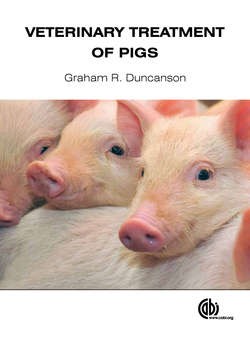Читать книгу Veterinary Treatment of Pigs - Graham R Duncanson - Страница 82
На сайте Литреса книга снята с продажи.
Manure disposal
ОглавлениеManure disposal is a difficult issue. On the one hand, the manure from one or two pigs can easily be mulched on a muckheap and dug into a vegetable garden. Equally, with a bigger operation the muck can be stored carefully and be taken away by a neighbouring farmer on a ‘straw-for-muck’ basis. It is the between-size operation where problems are likely to arise with not only the pig owner but also the neighbours. Careful commonsense education will have to be given.
Table 1.2. Checklist for completion of a herd health plan.
| Standard | Objective evidence |
| Traceability | The onus is on the pig keeper to record all movements either on or off the premises in the movement book. The pig keeper also has to record all medicines and their batch numbers given to the pigs |
| Tail docking | This is not advised and is permitted only on a written order from a veterinary surgeon that it needs to be performed on disease control grounds, for a limited period, until the situation is brought under control |
| Teeth clipping | This is no longer advised unless there is a specific problem. It should not be encouraged long term |
| Castration | This is not advised in a commercial situation. In a specific niche market where late maturing pig breeds are being kept, chemical castration should be considered (see Chapter 5, p. 48). Castration is advised only in pet pigs. In that situation the operation should be performed as early as possible at approximately 2 weeks of age |
| Prophylactic antibiotics | These are now banned in the EU and should be strongly discouraged in other areas of the world |
| Segregation of incoming pigs Welfare | This should be mandatory with as long an isolation period as possible A single person should be delegated as welfare officer. Any breaches of welfare standards should be recorded and new Standard Operating Procedures (SOPs) should be implemented as soon as possible |
| Regular inspection of pigs | Obligatory twice daily. More frequent inspections are required for parturient animals |
| Medicine record book | Obligatory |
| Knowledge of broken needle protocol | This should be available in writing (see below) |
| Withdrawal periods for medicines | These must be recorded for all medicines in the medicine record book. It should be remembered that any medicine used off licence has a meat withhold of 28 days |
| Records of births and deaths | This is strongly advised |
| Feed storage conditions | These should be checked weekly |
| Use of sticks, pipes or electric goads | Banned |
| Condition of structures and fittings | No sharp or broken gates or metal coverings |
| Condition of floors and bedding | Concrete to be checked monthly, bedding always to be adequate |
| Cleansing policy | A written good hygiene policy should always be followed |
| Temperature and ventilation | Adequate for each class of pig and able to be altered with extremes of weather conditions |
| Lighting | Adequate. Pigs must not live in darkness |
| Alarms | These are required only if there is mechanical temperature control practised. Smoke alarms are recommended |
| Pest control | Pigs must be kept vermin free. Bait must be protected from the pigs |
| Waste control | No excessive build-up of dung, particularly slurry |
| Water supply | This must be reliable even in severe frost |
| Piglet creep environment | This must be warm enough (see Housing section above) |
| Pig condition score | Pigs must not be too thin or obese. This is particularly relevant to pet pigs |
| Pig groups | Stability is important (practitioners should look for evidence of fighting) |
| Stocking density | Area must be sufficient for the number and size (see Housing section above) |
| Feeding space | Must be adequate (see Housing section above) |
| Level of antisocial behaviour and vice | Needs to be assessed with sympathy for the pigs and the pig keeper |
| Treatment of sick pigs | Must be prompt with the ability to move into separate pens |
| Provision for euthanasia | This should be a written policy with veterinary involvement (see Chapter 6) |
| Drainage and land suitability | This is particularly important with outdoor pigs. The whole area occupied by the pigs should be checked visually |
| Standard and positioning of accommodation | This should be visually assessed |
| Electric fence training and acclimatization | This is relevant to outdoor pigs. Pig keepers should be educated |
| Wallows and shade | This is relevant to outdoor pigs and should be visually assessed |
| Nose ringing practice | This is no longer acceptable as it contravenes one of the five welfare freedoms |
| Weaning environment | This is one of the most stressful events in a pig’s life. The environment should be visually appraised |
| Rotation of farrowing accommodation and location | Hygiene and education regarding straw burning |
Fig. 1.22. Pigs at shows are a danger to the public.
